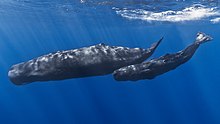
Back Potvis Afrikaans حوت العنبر Arabic حوت العنبر ARZ Physeter macrocephalus AST Odayol (Physeter catodon) AVK Kaşalot Azerbaijani Кашалот Byelorussian Кашалёт BE-X-OLD Кашалот Bulgarian আম্বর মাছ (তিমি) Bengali/Bangla
| Sperm whale[1] Temporal range:
| |
|---|---|

| |

| |
| Scientific classification | |
| Domain: | Eukaryota |
| Kingdom: | Animalia |
| Phylum: | Chordata |
| Class: | Mammalia |
| Order: | Artiodactyla |
| Infraorder: | Cetacea |
| Family: | Physeteridae |
| Genus: | Physeter |
| Species: | P. macrocephalus
|
| Binomial name | |
| Physeter macrocephalus | |

| |
| Major sperm whale grounds | |
| Synonyms | |
| |
The sperm whale or cachalot[a] (Physeter macrocephalus) is the largest of the toothed whales and the largest toothed predator. It is the only living member of the genus Physeter and one of three extant species in the sperm whale family, along with the pygmy sperm whale and dwarf sperm whale of the genus Kogia.
The sperm whale is a pelagic mammal with a worldwide range, and will migrate seasonally for feeding and breeding.[5] Females and young males live together in groups, while mature males (bulls) live solitary lives outside of the mating season. The females cooperate to protect and nurse their young. Females give birth every four to twenty years, and care for the calves for more than a decade. A mature, healthy sperm whale has no natural predators, although calves and weakened adults are sometimes killed by pods of killer whales (orcas).
Mature males average 16 metres (52 ft) in length, with the head representing up to one-third of the animal's length. Plunging to 2,250 metres (7,382 ft), it is the third deepest diving mammal, exceeded only by the southern elephant seal and Cuvier's beaked whale.[6][7] The sperm whale uses echolocation and vocalization with source level as loud as 236 decibels (re 1 μPa m) underwater,[8][9] the loudest of any animal.[10] It has the largest brain on Earth, more than five times heavier than a human's. Sperm whales can live 70 years or more.[11][12][13]
Sperm whales' heads are filled with a waxy substance called "spermaceti" (sperm oil), from which the whale derives its name. Spermaceti was a prime target of the whaling industry and was sought after for use in oil lamps, lubricants, and candles. Ambergris, a solid waxy waste product sometimes present in its digestive system, is still highly valued as a fixative in perfumes, among other uses. Beachcombers look out for ambergris as flotsam.[14] Sperm whaling was a major industry in the 19th century, depicted in the novel Moby-Dick. The species is protected by the International Whaling Commission moratorium, and is listed as vulnerable by the International Union for Conservation of Nature.
- ^ Mead, J. G.; Brownell, R. L. Jr. (2005). "Order Cetacea". In Wilson, D. E.; Reeder, D. M. (eds.). Mammal Species of the World: A Taxonomic and Geographic Reference (3rd ed.). Johns Hopkins University Press. p. 737. ISBN 978-0-8018-8221-0. OCLC 62265494.
- ^ "Physeter macrocephalus Linnaeus 1758 (sperm whale)". Fossilworks: Gateway to the Paleobiology Database. Retrieved 17 December 2021.
- ^ Taylor, B.L.; Baird, R.; Barlow, J.; Dawson, S.M.; Ford, J.; Mead, J.G.; Notarbartolo di Sciara, G.; Wade, P.; Pitman, R.L. (2019). "Physeter macrocephalus". IUCN Red List of Threatened Species. 2019: e.T41755A160983555. doi:10.2305/IUCN.UK.2008.RLTS.T41755A160983555.en. Retrieved 19 November 2021.
- ^ "Appendices | CITES". cites.org. Retrieved 14 January 2022.
- ^ "Sperm Whale". acsonline.org. Archived from the original on 22 April 2017. Retrieved 13 May 2017.
- ^ Cite error: The named reference
plosone-2014was invoked but never defined (see the help page). - ^ Cite error: The named reference
Elephantsealwas invoked but never defined (see the help page). - ^ Møhl, Bertel; Wahlberg, Magnus; Peter T. Madsen (2003). "The monopulsed nature of sperm whale clicks". The Journal of the Acoustical Society of America. 114 (2): 1143–1154. Bibcode:2003ASAJ..114.1143M. doi:10.1121/1.1586258. PMID 12942991.
- ^ Trivedi, Bijal P. (3 November 2003). "Sperm Whale "Voices" Used to Gauge Whales' Sizes". National Geographic. Archived from the original on 6 November 2003.
- ^ Davies, Ella. "The world's loudest animal might surprise you". BBC. Retrieved 13 January 2020.
- ^ Shirihai, H. & Jarrett, B. (2006). Whales, Dolphins, and Other Marine Mammals of the World. Princeton: Princeton Univ. Press. pp. 21–24. ISBN 978-0-691-12757-6.
- ^ Cite error: The named reference
audubonwas invoked but never defined (see the help page). - ^ Whitehead, H. & Weilgart, L. (2000). "The Sperm Whale". In Mann, J.; Connor, R.; Tyack, P. & Whitehead, H. (eds.). Cetacean Societies. The University of Chicago Press. p. 169. ISBN 978-0-226-50341-7.
- ^ Spitznagel, Eric (12 January 2012). "Ambergris, Treasure of the Deep". Bloomberg L.P. Retrieved 25 May 2017.
Cite error: There are <ref group=lower-alpha> tags or {{efn}} templates on this page, but the references will not show without a {{reflist|group=lower-alpha}} template or {{notelist}} template (see the help page).
© MMXXIII Rich X Search. We shall prevail. All rights reserved. Rich X Search
